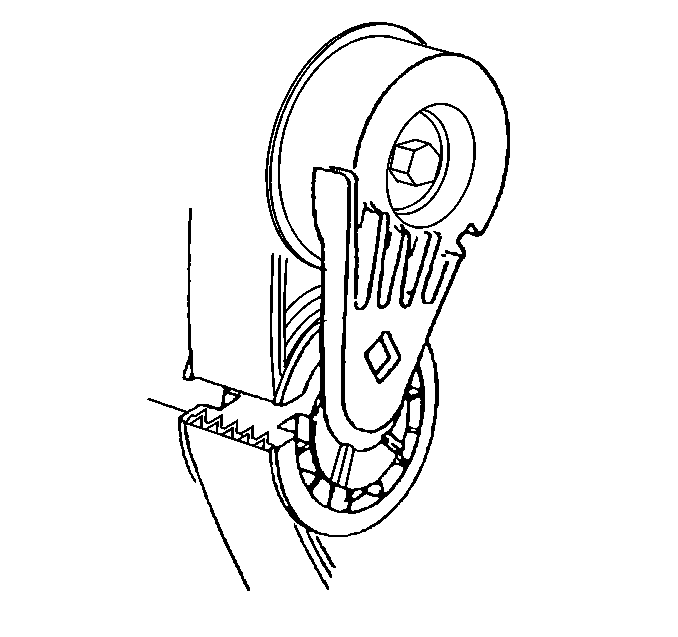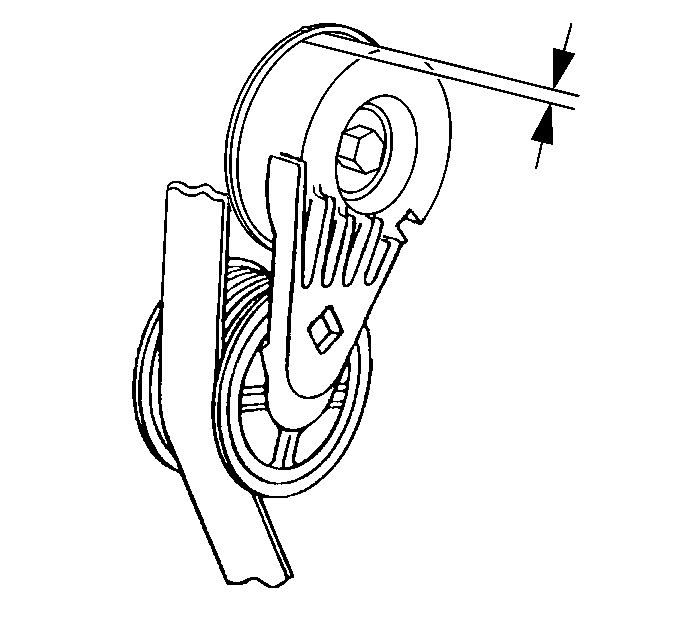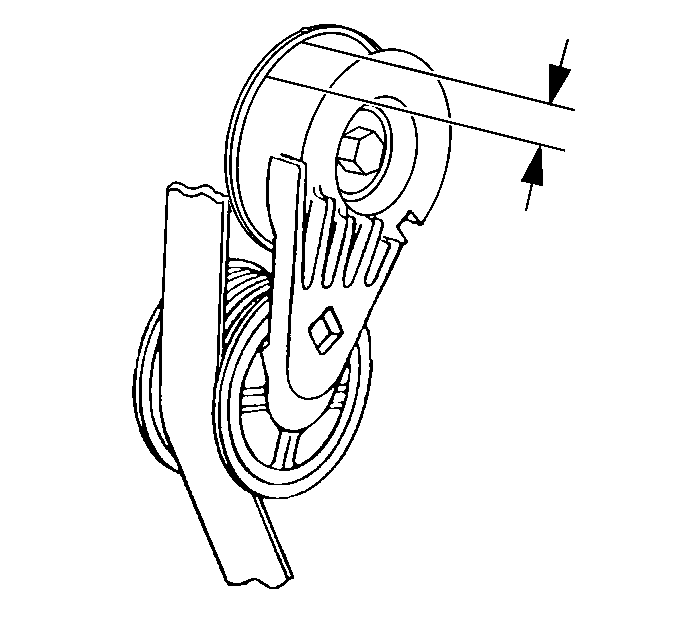| Table 1: | Drive Belt Chirping |
| Table 2: | Drive Belt Squeal |
| Table 3: | Drive Belt Whine |
| Table 4: | Drive Belt Rumbling |
| Table 5: | Drive Belt Vibration |
| Table 6: | Drive Belt Falls Off |
| Table 7: | Excessive Wear in Either Outside Groove of Drive Belt |
Definitions
The following are symptomatic noises of the drive belt system:
Chirping
The following items are indications of chirping:
| • | A high pitched noise that is usually heard once per revolution of a pulley or a belt. |
| • | It is most common on cold, damp mornings. |
| • | Verify this condition by squirting water onto the belt. The noise will momentarily stop. |
Squeal
The following items are indications of squeal:
| • | A loud screeching noise that is caused by a slipping belt (this is unusual for a belt with multiple ribs). |
| • | The noise occurs when a heavy load is applied to the belt, such as an air conditioning compressor engagement, snapping the throttle, or slipping on a seized pulley. |
Whine
A high pitched continuous noise that may be caused by a failed bearing.
Faint Cycle Rumbling
A low frequency noise heard once per revolution of the drive belt.
Pilling
The following items are indications of pilling:
| • | The random accumulation of rubber dust in the bottom of the multi-ribbed belt grooves. |
| • | A small amount of pilling is normal. |
| • | Operation of the drive belt system will not be effected unless the buildup exceeds one third (1/3) of the belt groove depth. |
Multiple-ribbed type drive belts wear evenly with their pulleys. Unusual wear indicates a correction is needed. The following diagnostic tables will aid in diagnosing drive belt system conditions.
Step | Action | Value(s) | Yes | No |
|---|---|---|---|---|
DEFINITION: A high pitched noise ususally heard once per revolution of a pulley or belt. It is usually heard at idle and is most common on cold damp mornings. Squirting water on a chirping belt will usually cause the noise to momentarily go away. | ||||
1 | Check for misalignment of the pulleys. Are any of the pulleys misaligned? | -- | ||
2 | Replace any misaligned pulleys. Is the chirp still present? | -- | System OK | |
3 | Check for bent or cracked brackets. Are there any bent or cracked brackets? | -- | ||
4 | Replace any bent or cracked brackets. Is the chirp still present? | -- | System OK | |
5 | Check for any loose or missing fasteners. Are there any loose or missing fasteners? | -- | ||
6 | Tighten any loose fasteners and properly install any missing fasteners. Refer to Fastener Tightening Specifications . Is the chirp still present? | -- | System OK | |
7 | Check for a bent pulley flange. Is the pulley flange bent? | -- | ||
8 | Replace the pulley flange. Is the chirp still present? | -- | System OK | |
9 | Check for severe pilling, exceeding 1/3 of the belt groove depth. Is there severe pilling? | -- | -- | |
10 | Replace the accessory drive belt. Refer to Drive Belt Replacement . Is the chirp still present? | -- | -- | System OK |
Step | Action | Value(s) | Yes | No |
|---|---|---|---|---|
1 | Check for a misaligned pulley. Is there a pulley misaligned? | |||
2 | Check for incorrect belt length, refer to Drive Belt Replacement Is the belt length correct? | |||
3 | Repair or install new parts as necessary. Is the repair complete? | System OK | ||
4 | Check for a malfunctioning drive belt tensioner, refer to Drive Belt Tensioner Diagnosis Is the tensioner malfunctioning? | |||
5 | Check for correct pulley size. Are the pulleys the correct size? | |||
6 | Check for siezed bearings. Is there a siezed bearing? | System OK |
Step | Action | Value | Yes | No |
|---|---|---|---|---|
1 | Check for a worn accessory component bearing. Is a bearing making the noise? | -- | System OK | |
2 | Install new parts as necessary Is the repair complete? | -- | System OK | -- |
Step | Action | Value(s) | Yes | No |
|---|---|---|---|---|
1 | Check for severe pilling. Is there severe pilling of more than 1/3 of the rib depth? | -- | System OK | |
2 | Clean the drive belt pulleys. Are the drive belt pulleys clean? | -- | ||
3 | Install a new accessory drive belt. Is the repair complete? | -- | System OK | -- |
Step | Action | Value(s) | Yes | No |
|---|---|---|---|---|
1 | Check for loose or missing fasteners. Are there loose or missing fasteners? | -- | ||
2 | Re-tighten or replace as necessary. Is the repair complete? | -- | System OK | -- |
3 | Check for damaged fan blades. Are there damaged fan blades? | -- | ||
4 | Replace as necessary. Refer to Fan Replacement in Engine Cooling. Is the replacement complete? | -- | System OK | -- |
5 | Check for a bent fan clutch or coolant pump shaft. Is the fan clutch or coolant pump shaft bent? | -- | ||
6 | Replace as necessary. Refer to Water Pump Replacement in Engine Cooling. Is the repair complete? | -- | System OK | -- |
7 | Check for bent or cracked brackets. Are there bent or cracked brackets? | -- | System OK | |
8 | Replace the brackets as necessary. Is the repair complete? | -- | System OK | -- |
Step | Action | Value(s) | Yes | No |
|---|---|---|---|---|
1 | Check for a misaligned or a bent pulley. Are the pulleys misaligned? | -- | ||
2 | Replace any misaligned or bent pulleys. Does the drive belt continue to fall off? | -- | System OK | |
3 | Check for a bent or a cracked bracket. Are any of the brackets bent or cracked? | -- | ||
4 | Replace the damaged brackets. Does the drive belt continue to fall off? | -- | System OK | |
5 | Check for loose or missing fasteners. Are there any loose or missing fasteners? | -- | ||
6 | Replace any missing fasteners and tighten to specifications. Refer to Fastener Tightening Specifications . Does the drive belt continue to fall off? | -- | System OK | |
7 | Check for a misaligned power steering pump pulley. Is the power steering pump pulley misaligned? | -- | ||
8 | Realign or replace the power steering pump pulley. Refer to Power Steering Pump Replacement in Power Steering. Does the drive belt continue to fall off? | -- | System OK | |
9 | Check for a damaged drive belt. Is the drive belt damaged? | -- | ||
10 | Replace the drive belt. Refer to Drive Belt Replacement . Does the drive belt continue to fall off? | -- | System OK | |
11 | Check for a malfunctioning drive belt tensioner. Is the drive belt tensioner malfunctioning? | -- | ||
12 | Replace the drive belt tensioner. Does the drive belt continue to fall off? | -- | System OK | |
13 | Check for worn idler or tensioner pulley bearings. Are the idler or tensioner pulley bearings worn? | -- | -- | |
14 | Replace the worn bearings. Does the drive belt continue to fall off? | -- | -- | System OK |
Step | Action | Value(s) | Yes | No |
|---|---|---|---|---|
1 | Check to see if the ribs in the drive belt do not match the grooves in the pulley. Do the ribs in the drive belt match the grooves in the pulley? | -- | -- | |
2 | Replace the accessory drive belt. Refer to Drive Belt Replacement . Is there still excessive wear in either outside groove of the drive belt? | -- | -- | System OK |
General Instructions
The following graphics illustrate the correct way to route the drive belt over the pulleys, and some examples of incorrect belt placement.
- Observe the drive belt correctly installed on the pulley.
- When installing a new drive belt, observe the indicator on the tensioner.
- When installing a used drive belt, observe the indicator on the tensioner.
- Observe these incorrectly installed drive belts:

Each groove on the drive belt rests inside a matching groove in the pulley.

A new drive belt should fall inside this range.

A used drive belt should fall inside this range.

Avoid mis-positioning the belt by one or more grooves.
